Written By: Joseph Gleasure [ Instagram ]
Edited by: XEONIQ [ Instagram | Tumblr ]
Contents
- Background
- “Vision of the Future” (1995-1996) and Redhill Laboratories (1997)
- What Is a Nomad Anyways? New Nomads and the Wearables Program (1998-1999)
- Levi’s ICD+: An Ambitious New Paradigm (2000-2001)
- The End of ICD+ (2001)
- Conclusion
- Sources
Editor’s Note: This is a huge read, but worth it for anyone with an interest in the history of wearable electronics, the Levi’s ICD+ project itself, or futurist techwear as a commercial concept, long before the genre was over-saturated with hypebeast streetwear and social media fashion. Jo has curated a large volume of content here, with high quality promotional scans and primary information from difficult to source print publications. The expanded history of ICD+ is delivered chronologically in the following sections below.
Background
In the 1990s Steven Mann, Thad Starner and a team at MIT’s Wearable computing Lab1 envisioned everyday people wearing clothes and accessories with an embedded intelligence; these concepts were initially referred to as “wearable electronics.”2 In their published manifesto they lamented how personal computers sat on users’ desks and had not lived up to their name, stating: “A person’s computer should be worn, much as eyeglasses or clothing are worn, and interact with the user based on the context of the situation.”3 While theirs was the first group to explore the possibilities of personal computers being fully integrated into all aspects of everyday life it was not until Philips Electronics presented their exhibition “Vision of the Future” in Eindhoven in 1995 4 that a commercial enterprise had attempted to set groundwork for a viable concept of wearable electronics that actual consumers could use.
“Vision of the Future” (1995-1996) and Redhill Laboratories (1997)
“Vision of the Future” was a project started in January 1995 by Philips Electronics.5 It came on the back of then CEO Stefano Marzano’s 1992 keynote speech “Flying over Las Vegas” for the 17th annual World Design Conference of the International Council of Societies in Ljubljana. In this speech Marzano warns of a future that if we are not careful will be ruled by “environmental carelessness and materialism supported by technology.”6 “Vision of the Future” was Philips’ response to Marzano’s prophecy and the result of a yearlong study that according to Marzano “set out to visualise how products may look like and work in ten years time, hypothesising that products would strive to meet people’s needs and desires, rather than viewing these innovations through a limited technological point of view.”7 The developed ideas were presented in an exhibition hosted at Philips Electronic’s headquarters at the Evoluon in Eindhoven. The Exhibition ran through 1996 and was accompanied by a book of the same name and a series of promotional films that communicated the project.8

Philips Electronics had a multi-disciplinary team work on the project that resulted in 60 concepts that were displayed during the exhibition through 45 short films and approximately 180 product models and simulations. The main products 9 developed were:
- Interactive Family Tree: An interactive picture frame that brings together existing material and organises it via a central ‘family network’ to present family relationships
- Home Heart and Wands: A black box interface called “the heart” controlled by a device called “the wand. This was essentially a precursor to smart home technology where all aspects of a home would be centrally controlled by a computer.
- Emotion Containers: Multimedia products designed to be given as special presents, they have a small screen, a speaker, and a scent compartment. They offer a more sensory ways of giving, not only as aesthetic objects in the own right but, also as carriers of messages of special significance.
- Shiva: A personal digital assistant to aid in multitasking.
- Mobile Diagnostics: Essentially mobile hospitals and medical equipment such as ECGs that we now see fitted in ambulances.
- Multimedia Dispenser: A kind of vending machine for archived electronic media such as sound, or video.
Although the more developed ideas in “Vision of the Future”10 did not result in any examples that could be classified as wearable electronics, what it achieved was laying a comprehensive groundwork for its commercial application.
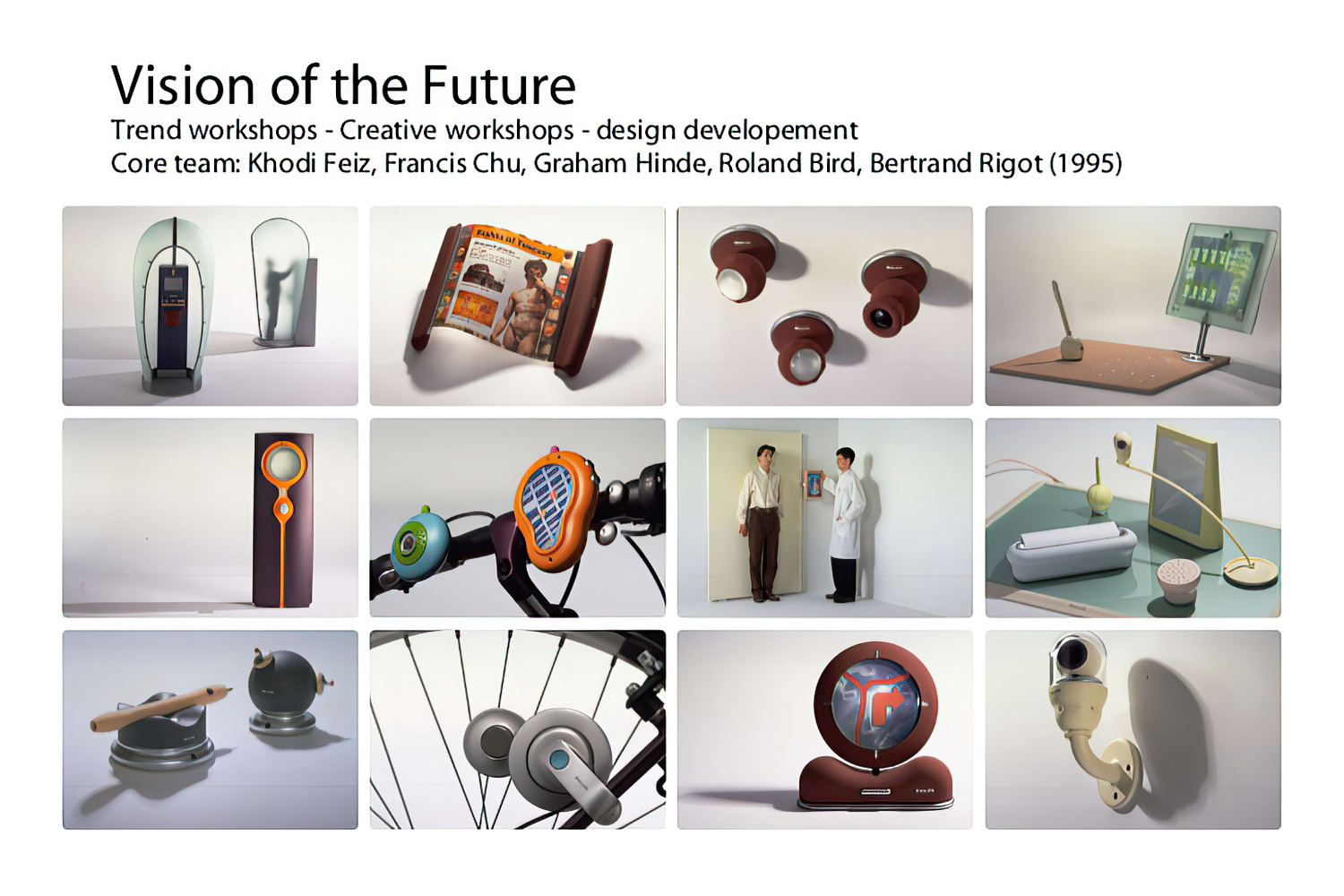
The very next year, Philips founded the Wearables program in 1997 as a part of their new Wearable Electronics Division. Headed by Clive van Heerden, Jack Mama and David Eves. This leadership group established a multi-disciplinary team made of engineers, scientists, designers, and trend forecasters at the Philips Research Laboratories campus in Redhill, UK ”which developed remarkably, derived from the outlandish idea of incorporating electronic devices into clothes and became known as Wearable Electronics.”11 focused on expanding Philip’s earlier research from “Vision of the future”. “Building upon Phillips Design’s initial exploration of wearable electronics as part of its “Vision of the Future” project, in the late 1990s Philips instigated a fresh approach to future lifestyle and fashion by creating a multi-disciplinary team to look at the integration of electronics into clothing.” Philip Research Laboratories also cited work done by the aforementioned MIT media lab as a pioneer in the field but, made very clear their intention with this new program was consumer applications12 looking to combine fashion with their technology.13
What Is a Nomad Anyways? New Nomads and the Wearables Program
According to Merriam-Webster a nomad is “a member of a people who have no fixed residence but move from place to place.”14 If you were to google the words “new nomads” today, you will see a series of articles on urbanites who love to travel, people who are simultaneously entrenched in society and somehow outside it.15 They have no fixed home and live on the road, their existence summarised in a book called “The New Nomads: Temporary Spaces and a Life on the Move” by Michelle Gallindo and Rober Klanten. If you can navigate the self-congratulatory treatises of travel blogs, you will find the archetype of the New Nomad: People (mostly urban) who require “new” flexible solutions to products and living space due to the transient demands of their lifestyle. However, the New Nomads are not new and in fact the MIT Media Lab had already been using the word nomad in its nomenclature since at least 1995 for their Nomadic Radio project.16 Furthermore Philips’ had recognized the “Nomads” as a potential customer and was designing for them by the late 1990s as the “Nomad” customer archetype was central to the Wearables program.

The work done by the Wearables Program team at Redhill is documented in the book “New Nomads an exploration of wearable electronics by Phillips”. It explains the continuation of goals first established by “Vision of the Future” and expands upon them in the context of blending electronic devices and fashion. “New Nomads” outlines Philips design philosophy by creating a framework of problems that it aimed to solve – from interactions between fashion and technology to the idealistic idea of self-fulfillment, and design concepts Philips’ would utilize to address them. Ideas like miniaturisation, deconstruction, smart textiles and the Body Area Network (BAN)17 among numerous others were explored through the prototypes designed at Redhill.18 The BAN would serve as the backbone for all of Philips’ integrated garments and would prove invaluable to the development of the ICD+ line of jackets developed in conjunction with Levi’s for Autumn Winter 2000 and Spring Summer 2001. The prototypes were then organized into 5 main categories of clothing that best reflect the needs of those Philips’ considered likely early adopters of digital clothing or the “new nomads”19 of their wearables program:
- Perform – Digital suits for professionals
- Work Out – Electronic Sportwear
- Enjoy – Interactive playsuits for Kids
- Connect – Wired streetwear for youth
- Embody – Enhanced body care and adornment
Additionally, “New Nomads” presented various scenarios for the end use of their products, childrenswear, outdooring gear, workwear uniforms, business suiting, music production, jewelry and club wear all outfitted with various electronic devices to allow the wearer to interact with their surrounding environment.
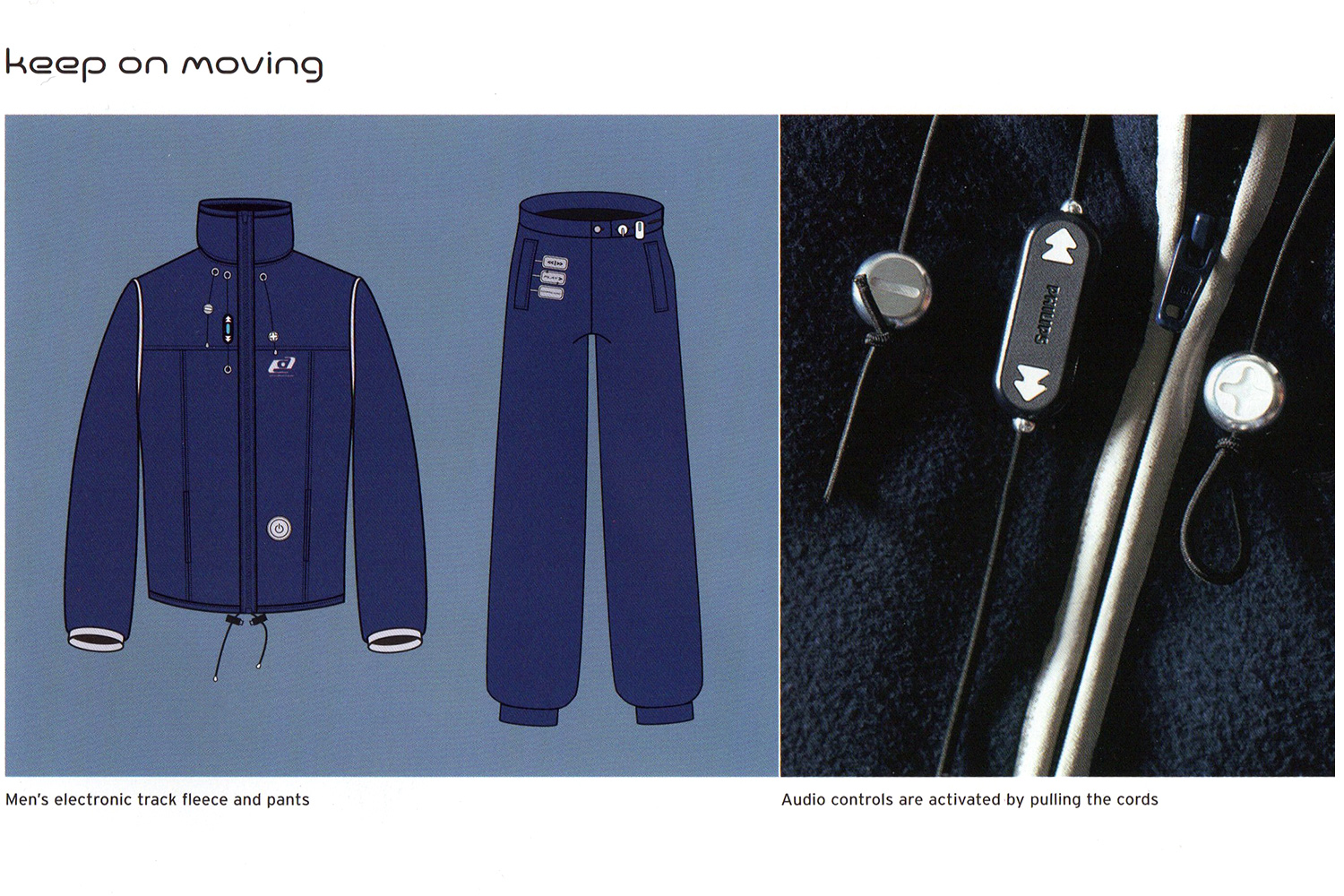
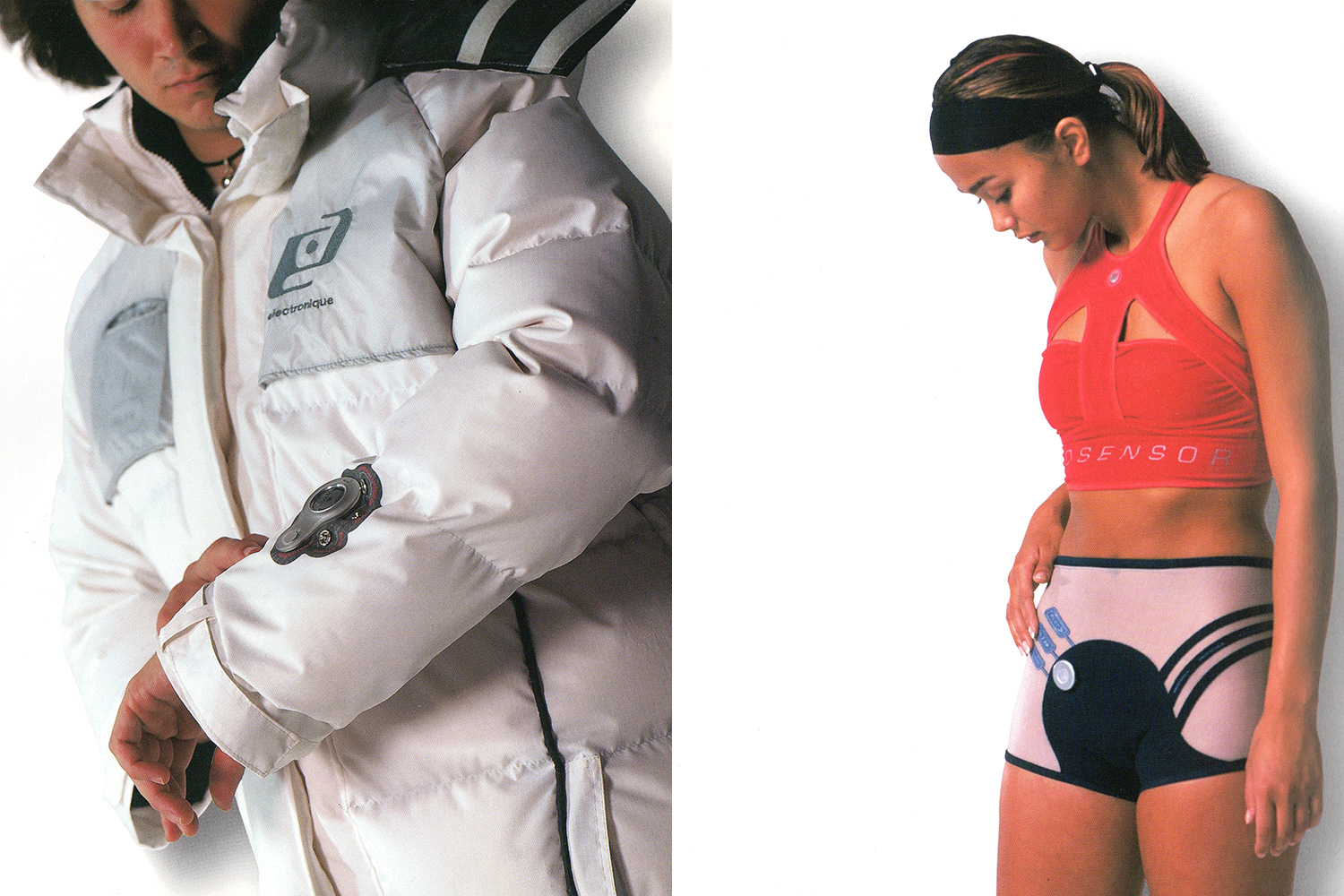
The first and incidentally most important scenario discussed in “New Nomads” is “nomadic working”.20 Philips’ teams at Redhill recognized that the way in which we live and work is increasingly taking place in transient spaces, what anthropologist Marc Augé described as “non-places”,21 to which individuals are connected in a uniform manner and where no organic social life is possible”.22 A sort of transitory place where we occupy but, cannot live in, that we all recognize but, has no specific geographic markers.23 It is precisely for non-places- Airports, highways, hotels, and supermarkets- that Philips’ was trying to design clothing and electronics for. Where Augé explained these non-places without much regard to the actual humans who have to occupy them, Phillips’ work at Redhill took a user centered approach stating “The traditional design disciplines are integrated with expertise from the human sciences and technology through a multi-disciplinary, research-based approach that makes it possible to create new solutions that satisfy and anticipate people’s needs and aspirations”.24
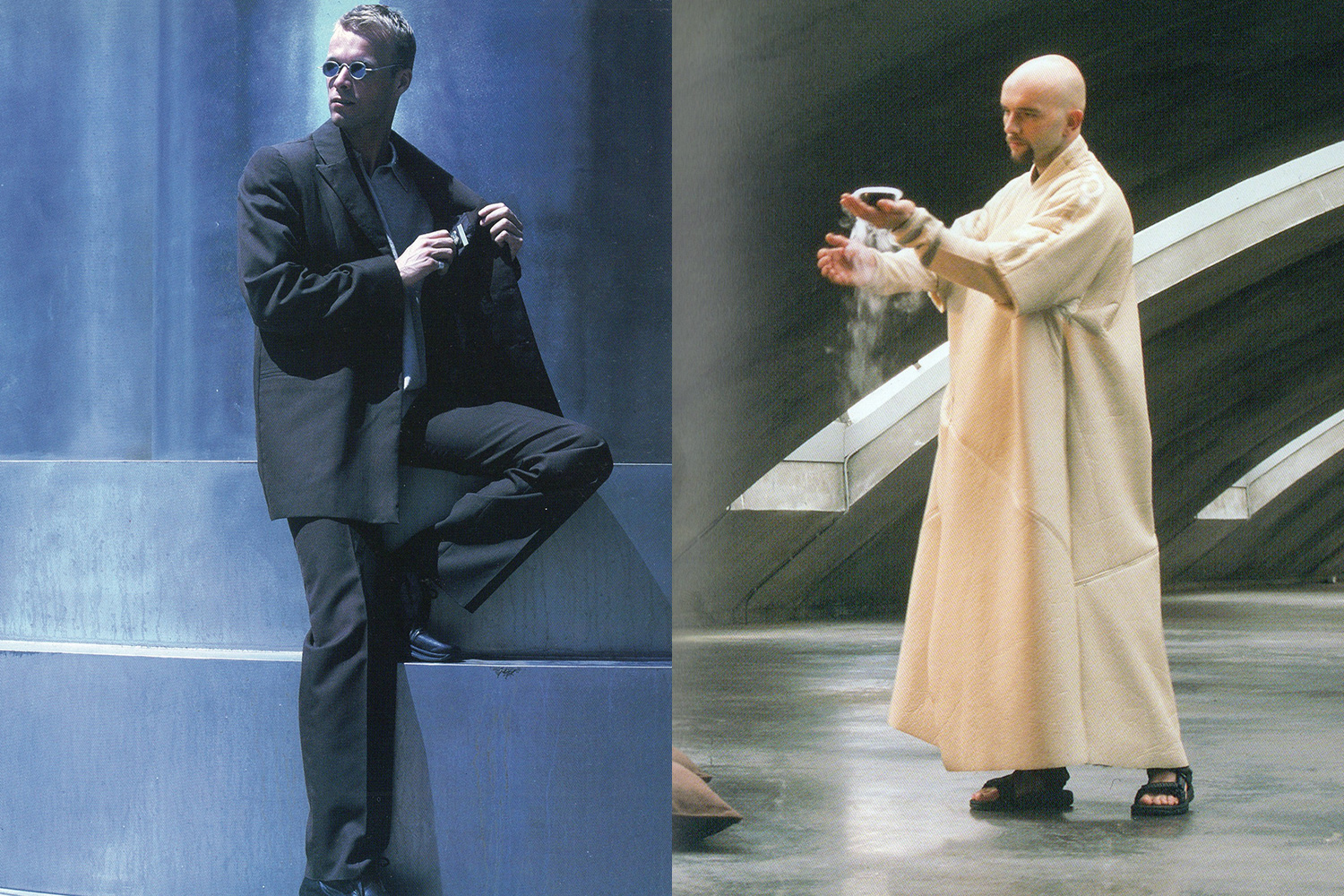
While the “New Nomads” project has since been criticized as “controlling ambition…that all our needs might be anticipated if only the right tool be found”25 according to Philips “the ultimate dream is not to have easier tools: it is not to have to bother with tools at all.”26 The aim of “New Nomads” was not to bombard the user with technology and extra tools to complicate daily life it was to integrate existing tools into holistic solutions. A suit with a keypad, for example, may appear to be two tools: one upholding societal dress expectations, the second a keypad for a phone; while a suit with a keypad is in actuality an intermediary to aid someone’s lifestyle. “clothing would become the product medium…the entire surface of the human body would available to create controls that were easier to use”.27 Philips Research Laboratories were not run by misanthropic cynics, the teams at Redhill were actively searching out positive anthropocentric solutions to the realities of postmodern living. For Philips’ “Our ultimate vision is that people will consider wearable electronics as part of getting dressed, that in the future all clothes will contain some infrastructure and some elements that add value to the net-work of electronics we have along our bodies.”28 That is to say, adapt electronics to daily life in ways that serve the users, not adapt humans to electronics that serve the companies that sell electronics.

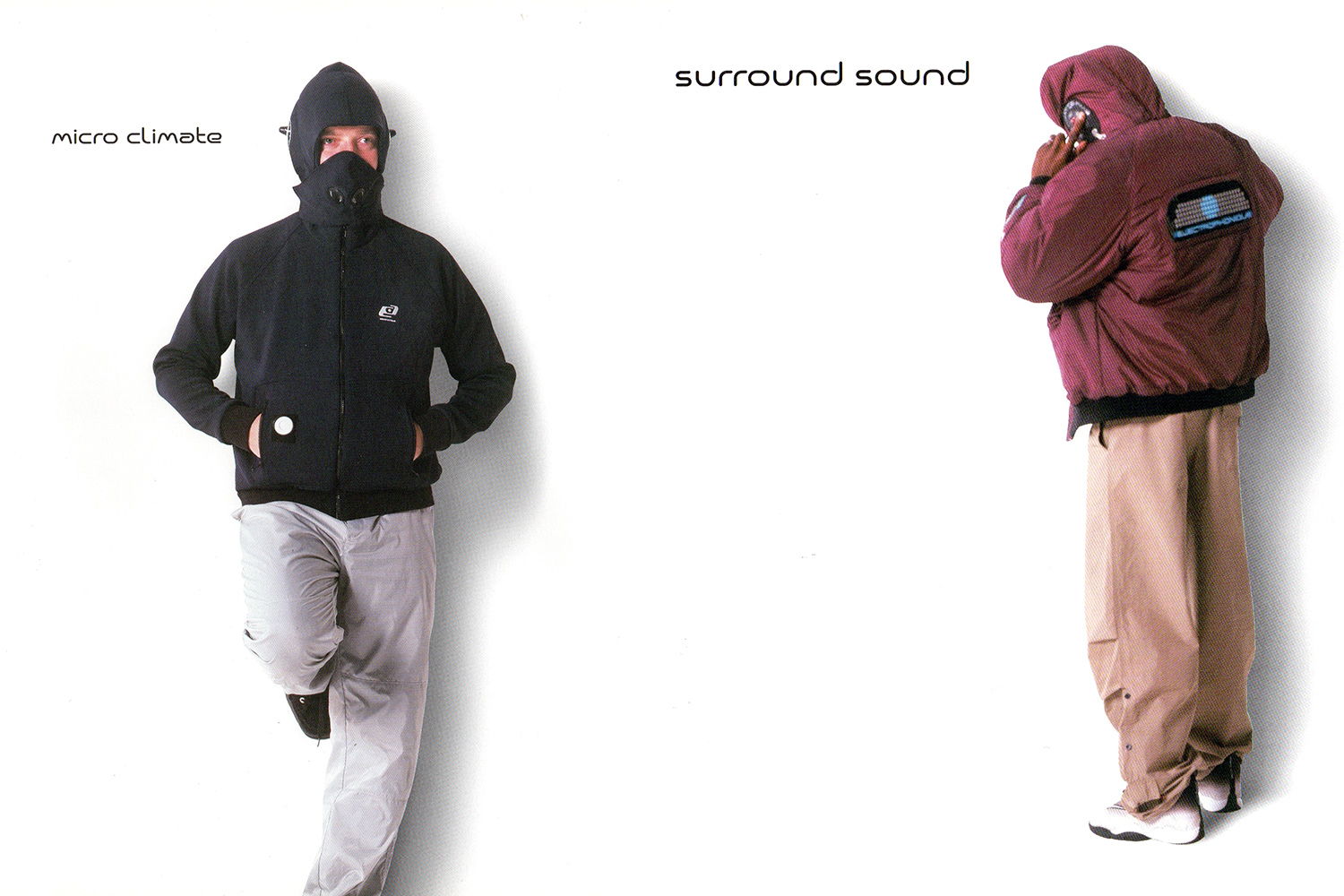
There were two main multi-disciplinary teams working at Redhill that collaborated on the “New Nomads” project: the Phillips Research Wearables Team that focused on the engineering and the Philips Design Wearables team who were tasked with the textile development and design of the clothing. The design team was led by Jack Mama with Nancy Tilbury and Philippa Wagner (a pair of Royal College of Art, UK MA graduates), in charge of apparel design and textile design respectively.2930 Although none of the prototypes presented in “New Nomads” were ever made into commercial products, Tilbury alongside Mama and Wagner were integral members of the teams that created the first commercial examples of wearable electronics with Levi’s and Nike. 31
In 1998 the wearables program presented their work at the Philips’ Concern Research Exhibition, a sold-out fashion show that aimed to raise the profile of the program within the company. This was followed a year later by a press release touting the work that the wearables program had developed. “A press release in August 1999 created enormous public interest and Philips was approached by several garment manufacturers keen to explore the concept further. One of these was Levi Strauss with whom an agreement on the development of a wearable product to test the market was reached.”32 This was the catalyst for the first commercial example of wearable electronics, the Levi’s Industrial Clothing Division Plus (ICD+)33 line of jackets.34
Levi’s ICD+: An Ambitious New Paradigm
Levi’s had already been working with designer Massimo Osti of C.P. Company and Stone Island fame in the late 1990s. Osti had designed a line in 199835 for Dockers called “Equipment for Legs” it featured high-tech fabrics such as Gore-Tex36 and “trousers with hidden pockets configured to hold specific kinds of electronic devices,”37 when Levi’s asked Osti to create an entirely new clothing line.
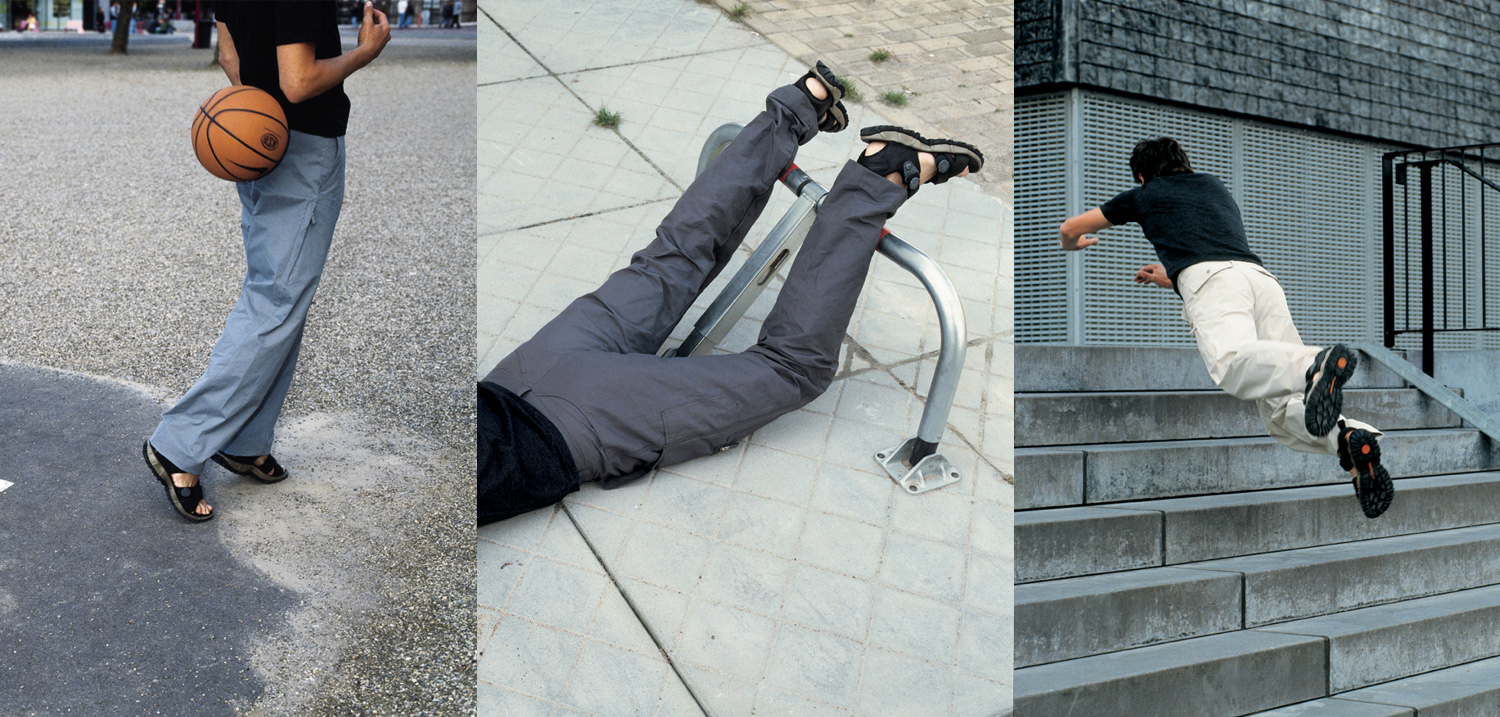
Osti’s resulting line was called “ICD”, an acronym for Industrial Clothing Division. It was a collection of roughly 35 items of urban garments inspired by Levi’s workwear heritage.38
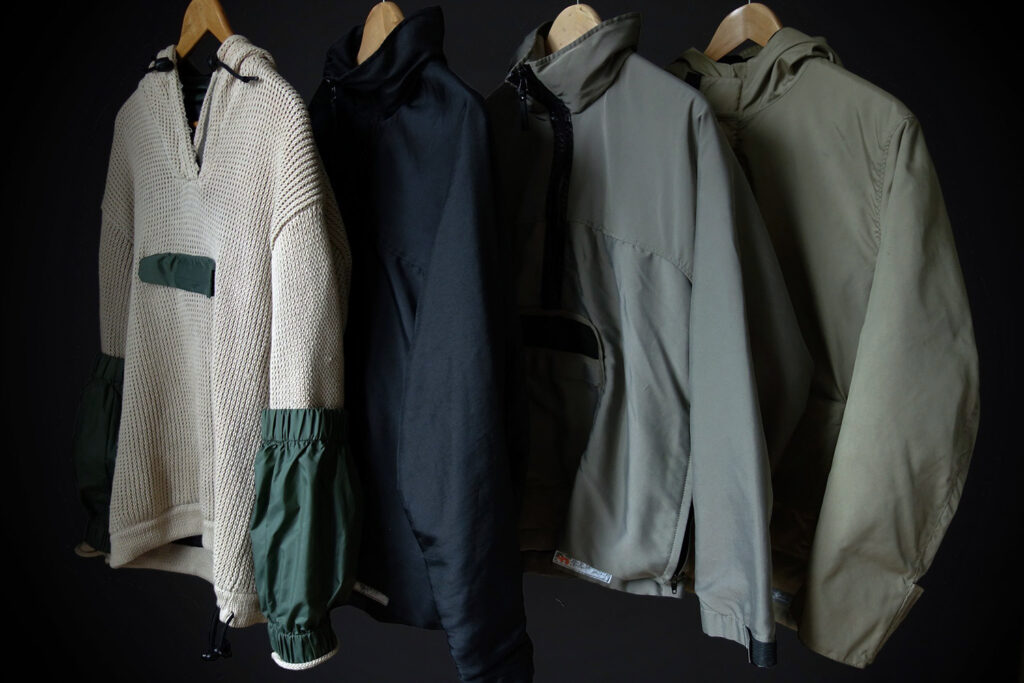
Branding was created by Mark Farrow who had famously done graphic design for musical groups The Pet Shop Boys and Spiritualized amongst others. The branding included not only the logo but, the design of the subsequent press kits and packaging that accompanied ICD garments. Following up on Phillips’ open call for a partner in August of 1999, four jackets with embedded Phillips electronics systems were designed by Levi’s, Philips, and Massimo Osti the line – called ICD+ -was the first commercial example of wearable electronics and the culmination of almost a decade of idea development by Philips.

For the scope of ICD+ Philips’ stated: “we identified a group we called ‘nomads’ who are constantly on the move,always in taxis or airports and needing to be wired, so we began looking for partners”.39 The four jackets were equipped with Philips’ PAN which served as the infrastructure network for all the additional electronics. The jackets came embedded with a Philips Rush! MP3 player, Philips voice activated Xenium 98940 mobile phone, a set of Philips Eargear headphones plus microphone all placed in specifically designed pockets and controlled by a common remote control.41

The four jacket styles in the ICD+ range42 were:
- Beetle: A water repellent, breathable durable shell for day to day protection in the city.
- Mooring: A versatile commuter garment, the interior vest would hold the electronics while the outer shell would protect against the elements.
- Producer: Likely taking its name from the producer jacket concept in “New Nomads” Producer was aimed at the needs of those working in the film and music industry.
- TRC Gilet: A simpler body warmer than the Producer, the Gilet could still hold items without needing a multitude of pockets. It was also made from Outlast® Phase Change Material
The inclusion of Outlast® PCM fabric is important to mention because, the ICD+ line has since been classified as a “mere carrying platform for the devices. That were only artificially linked”.43 However, with the inclusion of an “intelligent textile”44 like PCM, the mischaracterization of the jackets as a carrying platform makes considerably less sense and it would be more apt to view the jackets as intermediaries. As Marzano said, “They’ll change from being passive objects to active subjects.”45 The idea being that instead of fumbling around with multiple devices ICD+ provides a singular, streamlined solution for Philips’s “nomads”. This is further reinforced by the actual functionality of the jackets, if an individual is listening to music and receives a phone call, the remote control automatically switches from the MP3 player to the Phone, once the conversation is finished it switches back.46

Overall styling of ICD+ was done by Massimo Osti, and the design language is a clear continuation of his work under ICD, and Equipment for Legs: specialized compartments for electronic devices, high tech fabrics and plastic appliques similar to design details Osti’s former team was doing at C.P. Company for the Urban Protection collection and a slew of military garment references that has come to define much of Osti’s canon of work. However, the vital design of the PAN and integration of it into the garments was done by Jeni Arksey, fashion designer at Levi’s. and Philips’s Nancy Tilbury.47 Tilbury’s integration of the PAN was explained on VHM Design Future’s48 website “A hidden fabric loop and channel held the earphone wiring and routed it to the jacket hood where the earphones were housed until used… By keeping all the wiring hidden away inside the jacket it gave a clean and tidy finish and whilst allowing easy access to all the wearer’s electronic devices.”49 Osti’s experience and expertise as a constant innovator was essential to the success of the project. He was able to take Philips’s over stylized protypes and channel them through his own design language ensuring a chance at commercial success.
The original arrangement was that 2,500 jackets would be made by Levi’s with Philips providing the necessary electronic components however, Levi’s at a later stage reduced that number to 800 for the initial run.50 A press event was held in Eindhoven in July 2000,51 with fashion and tech journalists invited, press kits were created by Artomatic who also produced the packaging that came with every jacket. Artomatic had also previously worked with Mike Farrow on the packaging for Spiritualized’s Ladies and Gentlemen(1999) and previously produced a book for Levi’s premium denim line in 1999. The press kits came in a tin can and came with a flashlight, user manuals, a minidisc, and fabric samples of various items in the ICD52 range. Whereas the product packaging came in a mesh bag with a box holding the electronic components and manuals and the minidisc seen the press kit was also included.

The press release itself was a massive success. Phillips orchestrated the show and quite unlike traditional fashion presentations, models mingled with and addressed the audience, journalists were allowed to try on the garments and walk around in them while interacting with the multimedia show, and Peter Ingwersen, Stefano Marzano and Massimo Osti explained the concept directly to the audience. By all accounts it was a massive success in creating publicity, coverage of ICD+ and the launch were seen in publications such as The Guardian, The Wall Street Journal and on the BBC’s website53. Marzano explained that “ICD+ marks the beginning of a totally new lifestyle…the challenge in the press event was to communicate this to such a diversified audience. The only way to do it was to involve them personally and allow them to experience on their own skin what that new lifestyle could mean.”54
The collection was first sold in September 2000 55 and although ICD/ICD+ has been noted for poor sales leading to its cancellation,56 the AW2000 season was successful enough for Levi’s to ask Philips for a continuation through SS2001.57 How many new styles were created for the second season is unclear but, at least two new jackets appeared in the spring:
- The ‘Storage Jacket’58 – A packable jacket inspired by couriers designed to be worn like a bag over the shoulder when not in use. Pockets were on the outside to allow access to the electronic components even when the jacket was not worn.
- ‘Cagoon’ – This was similar to the TRC Gilet except that it contained a packable Mackintosh coat in a flat back panel, the electronics components could be accessed once the coat was unfolded and quite unusually it came with built in paper memo pad.
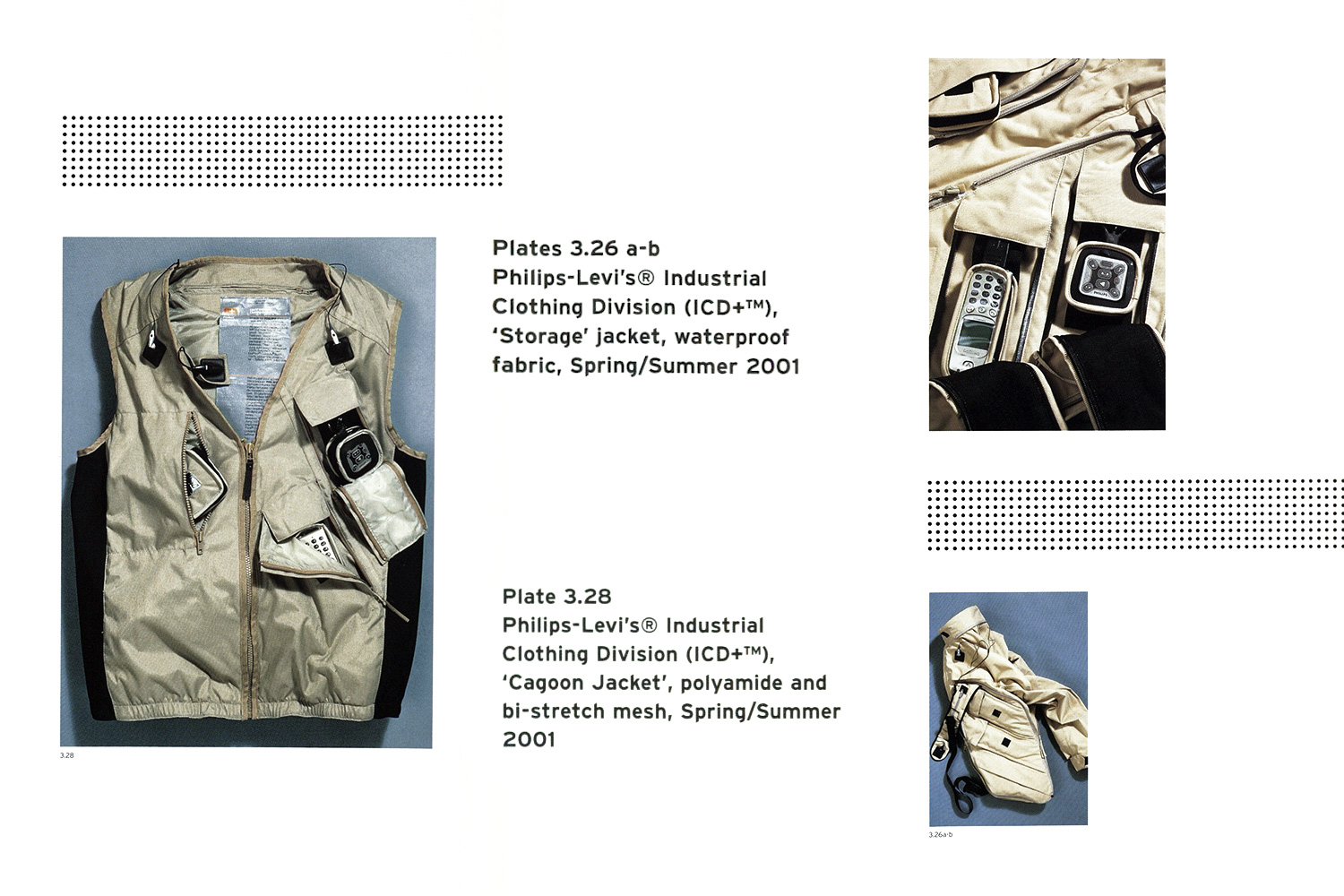
The End of ICD+
Levi’s did not choose to continue ICD+ after SS2001 and ICD also was discontinued at some point in 2001. As the Levis Osti Philips collaboration came to an end it revealed as McCann and Bryson observed “a statistical illusion that took many company heads, analysts and investors by surprise. Although the jacket received a staggering amount of media coverage…all the hype was never matched in sales. The audiences’ interest was pure curiosity”.60 It’s high price of £90061 combined with Levi’s relative lack of popularity at the time62 also likely contributed to poor sales. While ICD+ was unsuccessful it highlighted criteria for integrating technology into garments for commercial sale:
- Electronic devices cannot be bulky or rigid
- Devices must be encapsulated, removing electronics to wash a jacket isn’t practical
- Visible cabling is unaesthetic
- Energy sources must be embedded in textile structures. Carrying batteries in pockets is not a robust solution.
Philips had only addressed some of that criteria and combined with the other factors outlined above meant certain failure. However, Philips as the result of nearly a decade of work had managed to create an actual product and put it to market. They beat out companies such as Burton, The North Face , Nike, Adidas and Samsonite. who all were among the first companies to launch commercial of examples of wearable electronics.63 ICD+ is one of the most widely cited example of early wearable electronics and smartclothing in textile studies and is almost a requirement to mention in any paper or article on the merging of technology and fashion. Ironically enough it’s all but forgotten to fashion, not much more than a footnote for the most dedicated of Massimo Osti fans. A cursory search of secondhand menswear websites and forums reveals just a handful of hits.64 Compare this to other lauded menswear designers of the 90s and early 00s, there are over 20 examples of Helmut Lang’s Astro Biker Coat/Jacket for sale right now and a listing for a Raf Simons ‘riot riot riot’ Camo Bomber jacket is available in addition to dozens of other iconic Raf Simons pieces of outerwear. It is fascinating that even with the explosion of men’s archival clothing how few examples of Levi’s ICD+ jackets have appeared, testament to their obscurity. Levi’s ICD+ constitutes one of the most overlooked chapters in menswear history genuinely pioneering product design all but forgotten much like Philips’s own wearable program.

Philips’s wearables program was cast into uncertainty after ICD+. No internal division at Philips was prepared to pursue the program and as a result the board stopped the continuation of the work at Redhill. As Walling points out “ That was almost the end of the story except that in 2001 the sports equipment manufacturer Nike became interested in the possibility of building a heart rate monitor into a sports bra and Philips CE decided to take it up and to fund some work in PRL.”65 The staff that had worked on ”New Nomads” and ICD+ eventually created two more projects. One with Nike in 2004 which resulted in the Philips/Nike Heart rate monitor (HRM) that were integrated in bras, and eventually the Phillips/Nike PSA220 MP3 Player for running.66 The second project was called Skin: Dresses (2006) and was a concept design of a dress attempting to integrate “sensitive materials in the area of emotional sensing”67 a dress with attached electronics that would change colour to reflect the users mood. The Phillips Research Lab at Redhill would be moved in 2008 to Cambridge68 and many of the members of the wearable research and design teams would leave Philips. Nancy Tilbury would launch Studio XO in 201169, Clive van Heerden and Jack Mama founded VHM Design Futures in 201170 and Philippa Wagner moved to WGSN to do trend forecasting.71
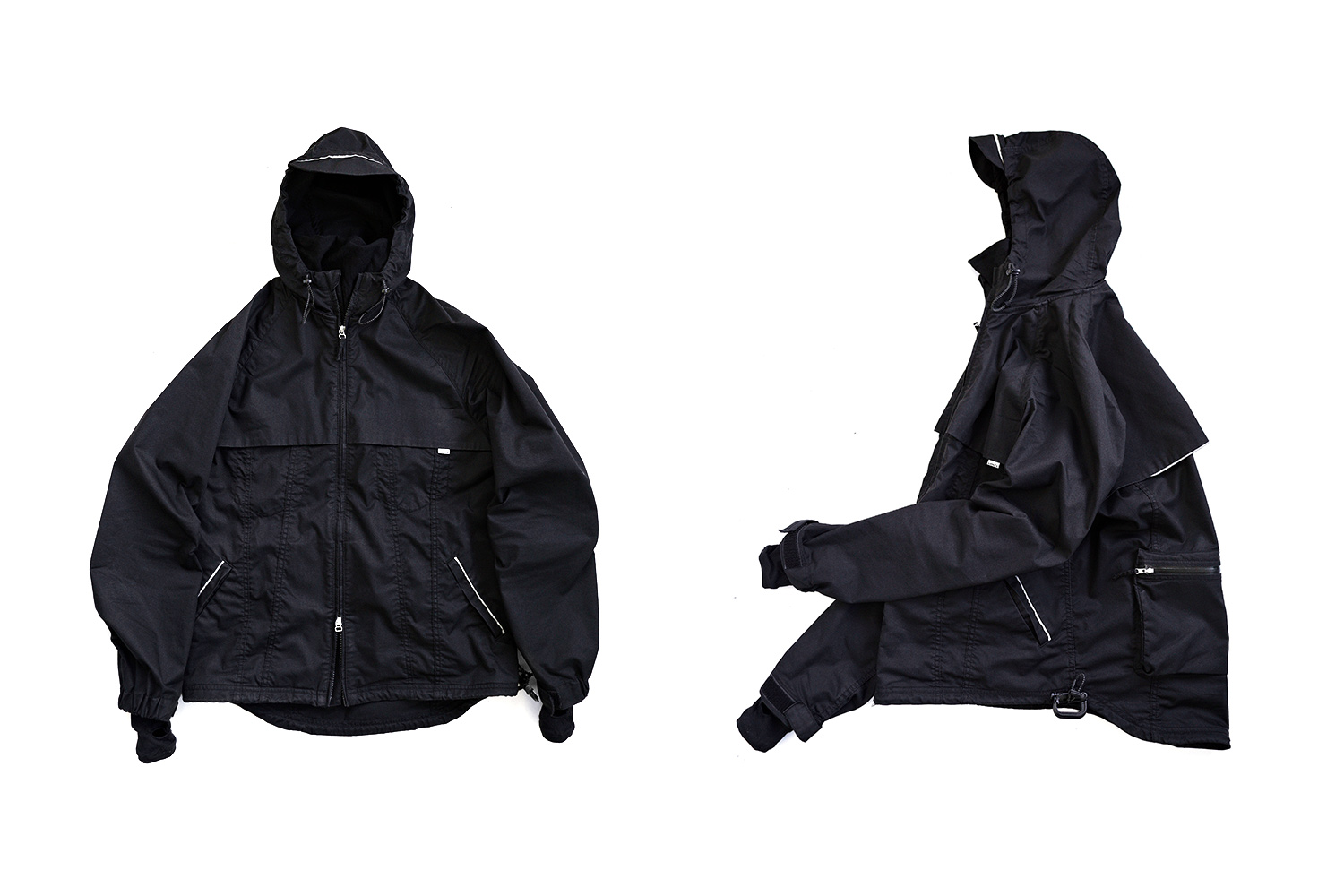
While Phillips stopped commercial attempts at wearable electronics and technology, Levi’s continued to explore technology driven solutions for urban dwellers. The Commuter line launched in 201172 was developed in conjunction with Schoeller73 and launched a collaboration in 2017 with Google to create the Levi’s® Commuter Trucker Jacket with Jacquard™ by Google.74
Conclusion
Phillips Wearables programme and ICD+ represent the culimination of an idealistic, romantic perspective with regards to the future of clothing. Rather than merely referencing futuristic tropes and aesthetics, these projects were an attempt to evolve clothing and merge it with state of the art technology. When we see current day techwear jackets using taped seams and breathable membranes, both decades-old technologies, being touted by their brands as “next level innovations”, we should keep in mind that companies like Phillips and Levi’s made a concentrated effort at actually bringing the future into reality some 20 years ago.
Fair Use Statement: This article contains images hosted without express permission from their copyright holders. These images are provided for illustration purposes to support an informational objective. This should constitute fair use of any such copyrighted material.
If you enjoyed this article, supporting SHELLZINE by any amount can be made via the link below. Your contribution is completely optional and all funds help cover the website’s growing hosting costs and enable further original content creation without the use of advertisements. Secure payments by all major card types, including Google Pay and Apple Pay, are supported.

Sources
- Fibretronic. (2009). Wearable reaches its 10th year.
- D.J. Tyler. (2013). Joining of wearable electronic components. (G. K. I Jones, Ed.) Joining Textiles:Principles and Applications, 507. doi:10.1533/9780857093967.4.507
- MIT Media Lab Human Dynamics. (2005). Wearable Computing.
- Chu, F. (2011, June 19). Francis Chu @ Philips Design.
- Lambourne, R., Feiz, K., & Rigot, B. (1997). Social trends and product opportunities: Philips’ Vision of the Future project. Chi ’97:Proceedings of the ACM SIGCHI Conference on Human factors in computing systems, p.494.
- Marzano, S. (1992). Flying Over Las Vegas. World Design Conference of the International Council of Societies(ICSID) (p. 4). Ljubjana: Philips Design.
- Marzano, S. (2018, July 1). Stefano Marzano Vision of the Future.
- Although the accompanying book is out of print the promotional films can be found here in two parts:
Vision of the Future Part 1 (1996)
Vision of the Future Part II (1996) - Lambourne, R., Feiz, K., & Rigot, B. (1997). Social trends and product opportunities: Philips’ Vision of the Future project. Chi ’97:Proceedings of the ACM SIGCHI Conference
- Future Lapse. (2017). Philips designs vision of the future 1997.
- Walling, J. (2005). The Mullard/Philips Research Laboratories,Redhill. A Short History 1946-2002. Redhill,Surrey,UK: Ruscombe Litho and Digital Printing Ltd. p.232
- Philips Electronics N.V. (2000). New Nomads An exploration of wearable electronics by Philips. Rotterdam: 010 Publishers.p.14
- Faringdon, J. (2001). Wearable Electronics and clothing from Philips and Levi. N/A, Abstract.
- Merriam-Webster. (2020). Nomad
- There may be a relevant point in examining Deleuze’s & Guattari’s use of a nomad as a metaphor for someone who is not fixed within a structure and is free to move at will. Especially given their popularity among writers like William Gibson.
- MIT Media Lab. (n.d). Project Nomadic Radio.
- It is also pertinent to note that sometime between 1998 and January of 2001 Philips’ had started referring to the BAN as Personal Area Network or (PAN), for the sake of this article it can be used interchangeably.
- Philips Electronics N.V. (2000). New Nomads An exploration of wearable electronics by Philips. Rotterdam: 010 Publishers. p.17
- Ryan, S. E. (2014). Garments of Paradise: Wearable Discourse in the Digital Age. Cambridge: MIT Press. p.113
- Philips Electronics N.V. (2000). New Nomads An exploration of wearable electronics by Philips. Rotterdam: 010 Publishers. p.26-33
- Foucault called these “other spaces”
- Augé, M. (1992). Non-lieux: introduction à une anthropologie de la surmodernité. London: Verso.
- Han Ibelings describes this homogenization of space with the point that Portland International Airport attracted national attention for using a different style of carpeting.
- Wallace, J., & Press, M. (2002, December). Craft Knowledge for the Digital Age – How the jeweller can contribute to designing wearable digital communication devices. P.5.
- Ryan, S. E. (2014). Garments of Paradise: Wearable Discourse in the Digital Age. Cambridge: MIT Press. p.116
- Wallace, J., & Press, M. (2002, December). Craft Knowledge for the Digital Age – How the jeweller can contribute to designing wearable digital communication devices. P.5.
- Philips Electronics N.V. (2000). New Nomads An exploration of wearable electronics by Philips. Rotterdam: 010 Publishers. p.16
- Philips Electronics N.V. (2000). New Nomads An exploration of wearable electronics by Philips. Rotterdam: 010 Publishers. p.22
- Philips Electronics N.V. (2000). New Nomads An exploration of wearable electronics by Philips. Rotterdam: 010 Publishers. p.146
- Studio XO on Wearable Tech – Extended Interview. (2014, May 21). YouTube
- Tilbury, N. (2020). LinkedIn Excerpt.
- Walling, J. (2005). The Mullard/Philips Research Laboratories,Redhill. A Short History 1946-2002. Redhill,Surrey,UK: Ruscombe Litho and Digital Printing Ltd. p.234
- ICD+ is often mistakenly said to stand for Industrial Clothing Design Plus.
- Collins, E. (2017, May 10). Levis ICD+ jacket with built in cellphone and mp3 player (2000-2002).
- Facchinato, D. (2016). Ideas From Massimo Osti (Second ed.). (L. Osti, & D. Facchinato, Eds.) Mantova, Italy: Publi Paolini. P.84
- Munk, N. (1999, April 12). How Levi’s Trashed a Great American Brand While Bob Haas pioneered benevolent management,his company came apart at the seams. Fortune Magazine.
- Slatalla, M. (1999, June 24). New York Times Archive Technology Circuits.
- Facchinato, D. (2016). Ideas From Massimo Osti (Second ed.). (L. Osti, & D. Facchinato, Eds.) Mantova, Italy: Publi Paolini. P.86
- Philips Design. (2001, January). ICD+: what is it all about? New Value News p.10
- This phone is also sometimes referred to as a Xenium GSM, even within official Philips literature
- Facchinato, D. (2016). Ideas From Massimo Osti (Second ed.). (L. Osti, & D. Facchinato, Eds.) Mantova, Italy: Publi Paolini. P.86
- Philips Design. (2000, April 28). ICD+ User Manual Revision 6.
- McCann, J., & Bryson, D. (2009). Smart Clothes and Wearable Technology. Amsterdam: Elsevier. p.13
- Sinclair, R. (2014). Textiles and Fashion: Materials,Design, and Technology . Amsterdam: Elsevier. p.355
- Philips Design. (2001, January). ICD+: what is it all about? New Value News, p. 9.
- Philips Design. (2001, January). ICD+: what is it all about? New Value News, p. 8.
- Philips Design. (2001, January). ICD+: what is it all about? New Value News, p. 11.
- VHM Design Futures is a Design Strategy firm founded in London in 2011 by former Phillips engineers and veterans of the Wearables program Jack Mama and Clive van Heerden.
- Mama, J., & van Heerden, C. (n.d.). 2000 Philips/Levis ICD+. Retrieved April 9, 2020, from VHM design futures: VHM design futures
- Walling, J. (2005). The Mullard/Philips Research Laboratories, Redhill. A Short History 1946-2002. Redhill,Surrey,UK: Ruscombe Litho and Digital Printing Ltd. p.234
- Philips Design. (2001, January). ICD+: what is it all about? New Value News, p. 13
- This is an interesting note, existing examples of the ICD+ press kits have fabric samples from ICD despite them being made for an ICD+ launch event.
- Wired Staff. (2000, August 10). E-Clothes Here,So is Fear. Wired.
O’Connell, S. (2000, August 14). Fibre Options. The Guardian.
BBC. (2000, August 16). ‘Techno Clothing hit high street. BBC News.
Latour, A. (2000, August 22). Philips and Levi Strauss Team Up To Create Ready-To-Wear Electronics. Wall Street Journal. - Philips Design. (2001, January). ICD+: what is it all about? New Value News, p. 13
- Ariyatum, B., Holland, R., Harrison, D., & Kazi, T. (2005). The Future Design Direction Of Smart Clothing Development. The Journal of Textile Institute, 199-210. doi:10.1533/joti.2004.0071 P. 202
- Sinclair, R. (2014). Textiles and Fashion: Materials,Design, and Technology . Amsterdam: Elsevier. p.367
Tech Hunter. (n.d.). Levi’s X Philips [ICD+].
Ryan, S. E. (2014). Garments of Paradise: Wearable Discourse in the Digital Age. Cambridge: MIT Press. p.118
McCann, J., & Bryson, D. (2009). Smart Clothes and Wearable Technology. Amsterdam: Elsevier. p.13 - Walling, J. (2005). The Mullard/Philips Research Laboratories,Redhill. A Short History 1946-2002. Redhill,Surrey,UK: Ruscombe Litho and Digital Printing Ltd. p.234
- Although a misnomer this style is almost always referred to as the ICD+ Courier Jacket on social media
- Bolton, A. (2002). The Supermodern Wardrobe. London: V&A Publications. p.53-55
- McCann, J., & Bryson, D. (2009). Smart Clothes and Wearable Technology. Amsterdam: Elsevier. p.13
- There is some debate over the actual prices of the jackets and many publications contradict each other, Philips’ reported the jackets retail price as £900 as of 2005 and most sources report a range of £600-£900
- Lee, L. (2000, March 13). Can Levi’s Be Cool Again? Bloomberg Buisness, p. 2000.
- Ariyatum, B., Holland, R., Harrison, D., & Kazi, T. (2005). The Future Design Direction Of Smart Clothing Development. The Journal of Textile Institute, 199-210. doi:10.1533/joti.2004.0071 P. 202
Cohen, M. (2002). A Survery of Emerging and Exotic Auditory Interfaces. Proceedings of the 2002 International Coference on Auditory Display (p. 7). Kyoto: Spatial Media Group,Human Interface Lab, University of Aizu. - A series of search results from common and niche menswear buying/selling platforms show that the most recent ICD+ jacket was sold two years ago on Grailed and the major menswear sites(ebay Grailed and yahoo japan auctions) have 0 results even in the case of ebay’s Italian site that usually is a treasure trove of obscure Osti garments
- Walling, J. (2005). The Mullard/Philips Research Laboratories,Redhill. A Short History 1946-2002. Redhill,Surrey,UK: Ruscombe Litho and Digital Printing Ltd. p.234-235
- HWM. (2004, August). Gadgets & Gear for your Sporting Lifestyle. HWM, p. 30.
- Raw Color & Brand, M. (2014). Skin: Dresses.
- World Heritage Encyclopedia. (2020). Philips.
- Compton, N. (2014, September 22). Studio XO, the “fashion laboratory” adding digital light and magic to what we wear. The Guardian.
- Raw Color & Brand, M. (2014). About Us.
- Udale, J. (2014). Textiles and Fashion: Exploring Printed Textiles, Knitwear, Embroidery, Menswear and Womenswear (1 ed.). London: A&C Black.
- Ko, L. (2011, July 5). Levi’s Launches the ‘Commuter’ Series, Tailored to the Demands of Urban Cyclists. 7X7.
- Yu, J. (2011, July 18). Behind the Line: Levi’s Commuter – Interview with Senior Designer, JeWon Yu. (S. Hotchkiss, Interviewer)
- Bohn, D. (2017, September 25). This Levi’s jacket with a smart sleeve is finally going on sale for $350. The Verge.
